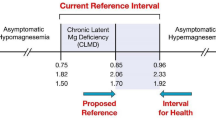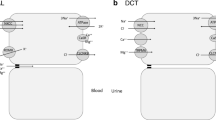Abstract
Measurement and monitoring of magnesium (Mg) are important to prevent the development of serious and potentially fatal complications in critically ill patients. Although ion-selective electrodes are available and earlier reports suggest that free ionized magnesium (iMg2+) is the most useful test to estimate Mg status, most clinical laboratories still only measure total Mg. To compare the relationship among iMg2+, total Mg, and albumin in serum, samples were collected from 48 consecutive patients admitted to an intensive care unit or a primary health center. The mean serum level of iMg2+ in 44 patients was 0.53 mmol/L, the total Mg was 0.06 mmol/L, and the albumin was 34.93 g/L. The correlation between iMg2+ and total Mg in serum was r=0.585; the correlation between iMg2+ and albumin in serum was r=378; and the correlation between total Mg and albumin in serum was r=0.340. The mean percent iMg2+ in relation to total Mg in serum was calculated to be 55% in the patient samples. The important level of biologically active iMg2+ was not reflected upon analysis of total Mg in 25% of consecutive patients. This report shows that the correlation of iMg2+ and total Mg is weak, not only in critically ill patients but also in patients in whom Mg status is inquired as a whole.
Similar content being viewed by others
References
W. J. Fawcett, E. J. Haxby, and D. A. Male, Magnesium: physiology and pharmacology, Br. J. Anesth. 83, 302–320 (1999).
G. T. Sanders, H. J. Huijgen, and R. Sanders, Magnesium in disease: a review with special emphasis on the serum ionized magensium, Clin. Chem. Lab. Med. 37, 2011–2033 (1999).
N.-E. L. Saris, E. Mervaala, H. Karppanen, J. A. Khawaja, and A. Lewenstam, Magnesium: an update on physiological, clinical and analytical aspects, Clin. Chim. Acta 294, 1–26 (2000).
J. M. Topf and P. T. Murray, Hypomagnesemia and hypermagnesemia, Rev. Endocr. Metab. Dis. 4, 195–206 (2003).
M. S. Seelig and R. J. Elin, Reexamination of magnesium infusion in myocardial infarction, Am. J. Cardiol. 76, 172–173 (1995).
D. Downing, Is ISIS-4 research misconduct? J. Nutr. Environ. Med. 9, 5–13 (1999).
M. Shechter, C. N. B. Merz, M. Paul-Labrador, et al., Oral magnesium supplementation inhibits platelet-dependent thrombosis in patients with coronary artery disease, Am. J. Cardiol. 84, 152–156 (1999).
P. A. Whiss and R. G. G. Andersson, Divalent cations and the protein surface coordinate the intensity of human platelet adhesion and P-selectin surface expression, Blood Coagul. Fibrinol. 13, 407–416 (2002).
H. J. Huijgen, H. E. van Ingen, W. T. Kok, and G. T. Sanders, Magnesium fractions in serum of healthy individuals and CAPD patients, measured by an ion-selective electrode and ultrafiltration, Clin. Biochem. 29, 261–266 (1996).
N. Fogh-Andersen and O. Siggaard-Andersen, Standardizing and reporting results from Mg2+ ISEs, with some notes to sample handling, Scand. J. Clin. Lab. Invest. 54, 89–96 (1994).
A. Lewenstam, N. Blomqvist, and J. Öst, Characterization, standardization and experiences with Kone ISE for Mg2+, Scand. J. Clin. Lab. Invest. 217, S37-S43 (1994).
H. J. Marsoner, U. E. Spichiger, C. H. Ritter, et al., Measurement of ionized magnesium with nautral carrier based ISEs. Progress and results with the AVL 988-4 magnesium analyser, Scand. J. Clin. Lab. Invest. 54, 45–51 (1994).
F. Zoppi, A. De Gasperi, E. Guagnellini, et al., Measurement of ionized magnesium with AVL 988/4 electrolyte analyzer: preliminary analytical and clinical results, Scand. J. Clin. Lab. Invest. 224, S259-S274 (1996).
J. L. Noronha and B. M. Matuschak, Magnesium in critical illness: metabolism, assessment, and treatment, Intensive Care Med. 28, 667–679 (2002).
B. T. Altura and B. M. Altura, Measurement of ionized magnesium in whole blood, plasma and serum with a new ion-selective electrode in healthy and diseased human subjects, Magnesium Trace Element 10, 90–98 (1992).
W. R. Kulpmann and M. Gerlach, Relationship between ionized and total magnesium in serum, Scand. J. Clin. Lab. Invest. 224, S251-S258 (1996).
S. Zehtabchi, R. Sinert, S. Rinnert, et al., Serum ionized magnesium levels and ionized calcium-to-magnesium ratios in adult patients with sickle cell anemia, Am. J. Hematol. 77, 215–222 (2004).
R. Mittendorf, J. Dambrosia, P. G. Pryde, et al., Association between the use of antenatal magnesium sulfate in preterm labor and adverse health outcomes in infants, Am. J. Obstet. Gynecol. 186, 1111–1118 (2002).
H. E. van Ingen, H. J. Huijgen, W. T. Kok, and G. T. Sanders, Analytical evaluation of Kone Microlyte determination of ionized magnesium, Clin. Chem. 40, 52–55 (1994).
H. Ising, F. Bertschat, T. Gunther, E. Jeremias, and A. Jeremias, Measurement of free magnesium in blood, serum and plasma with an ion-sensitive electrode, Eur. J. Clin. Chem. Clin. Biochem. 33, 365–371 (1995).
D. C. Greenway, J. T. Hindmarsh, J. Wang, J. A. Khodadeen, and P. C. Hebert, Reference interval for whole blood ionized magnesium in a healthy population and the stability of ionized magnesium under varied laboratory conditions, Clin. Biochem. 29, 515–520 (1996).
H. J. Huijgen, R. Sanders, S. A. Cecco, N. N. Rehak, G. T. Sanders, and R. J. Elin, Serum ionized magnesium: comparison of results obtained with three ion-selective analyzers, Clin. Chem. Lab. Med. 37, 465–470 (1999).
G. Matthiesen, K. Olofsson, and M. Rudnicki, Influence of blood sampling techniques on ionized magnesium level, Scand. J. Clin. Lab. Invest. 62, 565–568 (2002).
I. J. Newhouse, K. P. Johnson, W. J. Montelpare, and J. E. McAuliffe, Variability within individuals of plasma ionic magnesium concentrations, BMC Physiology 2 (2002) [http://www.biomedcentral.com/bmcphysiol/about/].
P. Rustad, P. Felding, L. Franzson, et al., The Nordic Reference Interval Project 2000: recommended reference intervals for 25 common biochemical properties, Scand. J. Clin. Lab. Invest. 64, 271–284 (2004).
Author information
Authors and Affiliations
Rights and permissions
About this article
Cite this article
Johansson, M., Whiss, P.A. Weak relationship between ionized and total magnesium in serum of patients requiring magnesium status. Biol Trace Elem Res 115, 13–21 (2007). https://doi.org/10.1385/BTER:115:1:13
Received:
Accepted:
Issue Date:
DOI: https://doi.org/10.1385/BTER:115:1:13




